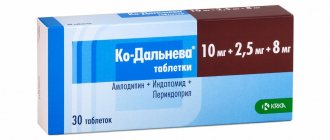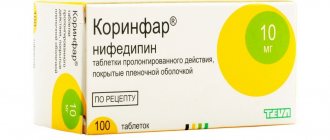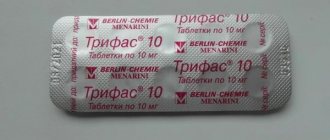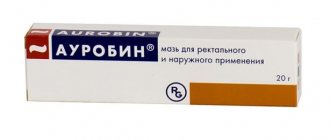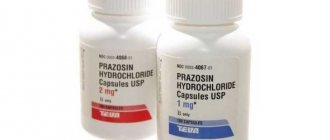Release forms and composition of the drug
The drug is available in several forms:
| Type of drug | Description | Package |
| Film-coated tablets, long-acting | Shape: elongated oval, with a middle break mark. Color: red-gray or pale burgundy. | 10 units of product in 1 blister pack. Each cardboard box contains 5-10 packages. |
| Dragee | Shape: regular symmetrical biconvex shape. Color: yellow or light yellow. | 10 units of product in 1 blister pack. Each cardboard box contains 5 packages. |
| Coated tablets | Shape: symmetrical, round, convex on both sides. Yellow color. | |
| Pills | Shape: symmetrical, flat-cylindrical, with a middle chamfer. Yellow color. | 10 or 25 units of product in 1 aluminum contour-cell packaging. Each cardboard box contains 2 or 5 packages. |
The drug contains:
| Form of production | Active ingredient Nifedipine, volume | Additional connections | Substances forming the shell |
| Long-acting film-coated tablets | 20 mg |
|
|
| Dragee | 10 mg |
|
|
| Coated tablets |
|
| |
| Pills |
| — |
Pharmacological properties
Nifedipine is often used during pregnancy in the third trimester, but its use should be agreed with a specialist, since the drug is a strong antihypertensive drug for the treatment of severe cardiac and vascular pathologies.
The active component of Nifedipine is a secondary structural analogue of 1,4-dihydropyridine.
The drug has registration identifier 21829-25-4 and is an active calcium-conducting channel blocker.
Pharmacodynamics
Cardiomyocyte cells have a semi-permeable membrane that is capable of conducting ions of nutrients and mineral compounds. Nifedipine helps inhibit the flow of calcium in the ducts. This helps reduce the total amount of calcium in cellular structures.
This process is accompanied by an increase in the lumen of large arteries and vessels of different capacities, which leads to a general decrease in vascular resistance to blood flow. This reduces blood pressure and the load on the heart muscle, and oxygen saturation of the myocardium increases.
Nifedipine also helps preserve the energy reserves of the heart, inhibiting the flow and increase in the concentration of calcium ions, which determines its protective effect on the heart muscles. The drug allows you to stabilize blood pressure, which reduces pain and discomfort in the chest area, which are caused by oxygen starvation.
In the presence of the initial stage of atherosclerosis and thrombosis, Nifedipine improves the supply of blood and nutrients to the coronary arteries, and also reduces the symptoms of obstruction of the vascular walls. The active ingredient of the drug also helps to reduce the ability of platelets to fuse into dense atherosclerotic formations.
The drug relieves spasms of vascular smooth muscles, so a decrease in heart rate and myocardial function may be observed when taking Nifedipine for the first time. Normal activity of the heart and vascular system organs is restored after a few days of therapy.
Nifedipine also exhibits the properties of mood stabilizers, stabilizing the emotional background and improving mood. This effect helps reduce headaches and reduce spasms of smooth muscles of other organs.
The drug stimulates an increase in blood flow in the renal structures, and also regulates the excretion of sodium and its salts through the kidneys. This property allows you to control the functioning of the genitourinary system, reducing the degree of edema and maintaining the water-salt balance within acceptable normal limits.
The tablet form of the product with an increased duration of action has a slower release of the active component. The duration of action of 1 unit of Nifedipine varies from 20 to 24 hours.
Nifedipine during pregnancy in the third trimester is also used as a tocolytic agent: it helps to relax the smooth muscles of the myometrial layer of the uterus. This allows you to reduce its tone, as well as reduce the risk of premature birth.
During the active phase of the birth process, the drug is prescribed to shift the time of the fetus’s exit from the uterine cavity, which allows for complete maturation of the entire respiratory system of the baby.
A stable decrease in blood pressure occurs only on the 3rd day after the first dose of the drug, and on the 4th week there is a complete disappearance of symptoms of chest tightness. But it is worth noting that using the product for 3 or more months causes addiction to the active substance and a decrease in the severity of its action.
Pharmacokinetics
The release of the active component occurs gradually. It is quickly and completely absorbed into the bloodstream from the intestines. When taking Nifedipine after meals, its absorption increases several times.
The absorption of the drug upon first release of the active compound is 60%.
90% of the drug binds to protein molecules in the blood plasma. The maximum concentration of the substance in the blood is reached after 28 minutes. The half-life is about 3 hours.
The first effect of oral administration of the drug is noticeable after 40 minutes. after administration, duration of action:
- for tablets 20 mg - about 24 hours;
- for tablets and dragees 10 mg - about 6 hours.
Chewing the drug speeds up the absorption process. When Nifedipine is absorbed, the maximum concentration of the active compound in the blood is reached after 15 minutes. About 5% of the drug crosses the placental barrier, and 40% passes into breast milk.
Nifedipine is excreted in the urine almost completely transformed : 1% in its original form, 80% in the form of metabolites. Complete elimination occurs 20 hours after taking the drug. About 15% of the product is excreted in the feces. If there are problems with the kidneys or liver, the elimination period may increase.
Composition and action of Nifedipine
The active component of the drug is nifedipine, a substance belonging to the class of slow calcium channel blockers. The drug has antihypertensive and antianginal properties, that is, it lowers blood pressure and prevents angina attacks . Its use helps improve well-being in diseases of the cardiovascular system.
When the medication enters the body of a pregnant woman, it begins to:
- blocking calcium deposits on the walls of blood vessels;
- expansion and improvement of elasticity of blood vessels;
- decrease in the number of heart contractions;
- reducing myocardial oxygen demand;
- lowering high blood pressure;
- removal of excess sodium and potassium;
- relaxation of the uterine muscles.
When taken orally, the medicine is quickly and completely absorbed, penetrating into the general bloodstream, and from there into the central nervous system and through the placental barrier.
Nifedipine reduces high blood pressure
The action of Nifedipine begins on average 20 minutes after consumption (chewing accelerates the effect) and lasts for 4–6 hours.
Indications for use during pregnancy
Nifedipine is most often prescribed during pregnancy in the third trimester.
It is used for:
- heart rhythm disturbances in a dynamic or calm state;
- chronic angina;
- high blood pressure;
- chronic headaches;
- Raynaud's syndrome;
- increased tone of the uterus;
- threat of early delivery;
- gestosis in the second and third trimester.
When and why are Nifedipine tablets prescribed during pregnancy?
So, the doctor prescribes this drug to pregnant women only in extreme cases. Such a categorical indication during the period of bearing a child can be:
- high blood pressure, which is difficult to relieve with other medications;
- hypertonicity of the uterus;
- angina pectoris;
- hypertensive crisis.
It should be added that a pregnant woman has two types of high blood pressure: chronic or acquired (gestational). Chronic hypertension occurs even before conception, and acquired hypertension occurs during pregnancy, most often in the second trimester.
If the female body has already adapted to the chronic form, then the gestational form can lead to serious complications - edema, late toxicosis, eclampsia combined with convulsions. In this case, doctors prescribe Nifedipine, which helps to smoothly but steadily lower blood pressure and improve cerebral blood flow. In obstetric and gynecological practice, the drug is also used as a tocolytic (a substance that stops premature labor) in case of threat of miscarriage .
With high blood pressure, the risk of spontaneous abortion exists in 25% of women. In this case, Nifedipine is especially effective.
Contraindications
Absolute contraindications include:
- hypersensitivity to the components of the product;
- decompensatory heart failure;
- cardiogenic shock;
- heart attack in the acute stage;
- low pressure;
- narrowing of the heart valves;
- cardiomyopathy;
- severe tachycardia;
- lactose deficiency;
- glucose and galactose intolerance;
- gestation period up to 20 weeks;
- age under 18 years;
- breast-feeding.
Nifedipine should be taken with caution when:
- heart pathologies;
- narrowing of the mitral valve;
- bradycardia;
- diabetes mellitus;
- renal failure;
- liver pathologies;
- encephalopathy;
- thrombosis in the acute stage.
It is also recommended to take Nifedipine under the supervision of a specialist for elderly people and patients undergoing hardware blood purification.
Contraindications and possible negative reactions
Despite the fact that treatment with Nifedipine brings good results, it has a number of contraindications that must be taken into account before taking it:
- acute heart failure;
- hypotension and other diseases accompanied by low blood pressure;
- allergy to any of the components of the product;
- age under 18 years;
- lactation period (when taking the drug, breastfeeding is temporarily stopped);
- first trimester of pregnancy.
In addition, the use of this medication can lead to serious complications for women with diabetes, liver and kidney diseases.
If the dosage is too high or there is an individual intolerance to the components of the medication, side effects may occur. The most common symptoms include allergic reactions (itching, redness, urticaria, etc.), difficulties in the respiratory system (shortness of breath, bronchospasm), sleep and vision disturbances, as well as low blood pressure.
If you feel unwell after taking Nifedipine, you need to inform your doctor, maybe he will adjust the dose of the medicine or stop it altogether.
Table: side effects from taking Nifedipine according to the instructions
| The cardiovascular system | Nervous system | Digestive system | Muscular and skeletal systems |
|
. |
|
|
Based on obstetric practice and numerous positive reviews from women who have already been treated with Nifedipine, the drug is well tolerated and does not cause serious complications in the mother and child. But, of course, we should not forget that therapy is carried out only in extreme situations after the doctor has assessed all possible risks and complications.
Interaction with other drugs
Nifedipine should be taken with caution when taking other medications, as it may affect their action. . Nifedipine reduces the level of Quinidine (used for the treatment and prevention of cardiac pathologies of varying severity) in the blood. Increases the concentration of Digoxin (cardiotonic and antiarrhythmic drug) and Theophylline (bronchodilator) in blood plasma. Co-administration of beta-blockers (heart medications) may lower blood pressure too much. The decrease in blood pressure is enhanced when taken simultaneously with other antihypertensive (pressure-reducing) drugs, cimetidine and ranitidine (anti-ulcer drugs), diuretics (diuretics) and tricyclic antidepressants (used in the treatment of diseases of the central nervous system).
- Nifedipine reduces the level of Quinidine (used for the treatment and prevention of cardiac pathologies of varying severity) in the blood.
- Increases the concentration of Digoxin (cardiotonic and antiarrhythmic drug) and Theophylline (bronchodilator) in blood plasma.
- Co-administration of beta-blockers (heart medications) may lower blood pressure too much.
- The decrease in blood pressure is enhanced when taken simultaneously with other antihypertensive (pressure-reducing) drugs, cimetidine and ranitidine (anti-ulcer drugs), diuretics (diuretics) and tricyclic antidepressants (used in the treatment of diseases of the central nervous system).
However, not only Nifedipine can affect drugs, but also vice versa:
- when taken simultaneously with nitrates, the hypotensive effect of Nifedipine increases, which causes tachycardia;
- Rifampicin (a broad-spectrum antibiotic) weakens the effect of Nifedipine;
- when taken together with drugs containing calcium, the effect of Nifedipine is reduced;
- parallel intake with magnesium leads to the development of muscle weakness.
If Nifedipine is used correctly in combination with other medications, you can significantly enhance its effect, but at the same time reduce the dosage, thereby reducing the risk of the drug’s possible effect on the unborn baby.
Instructions for use, dosage of the drug
Nifedipine in tablet and dragee form must be taken orally with a small amount of water. The drug can be taken at any time, regardless of food.
In the first trimester
According to the FDA, Nifedipine is classified as a highly toxic and teratogenic drug, that is, the active substance can cause disturbances in the development of the fetus. It also penetrates the protective barrier in the mother's placenta, so use of the drug in the first trimester is prohibited.
Up to 20 weeks, taking Nifedipine can cause the fetus to:
- malformations of internal organs and systems;
- inhibition of fetal growth and development;
- pathologies of the cardiac system;
- intrauterine death.
Nifedipine is a highly toxic drug.
During pregnancy, up to 20 weeks, it can cause intrauterine fetal death. Nifedipine also provokes pregnancy loss. Therapy for increased uterine tone should be carried out under the supervision of an obstetrician-gynecologist using similar less toxic drugs.
In the second trimester
From week 20, Nifedipine is allowed. The maximum daily dose should not exceed 60 mg. Depending on the severity of symptoms of uterine hypertonicity or arterial hypertension, the obstetrician prescribes 1 or 2 tablets. Nifedipine. The duration of therapy is from 1 to 6 weeks.
In the third trimester
Nifedipine during pregnancy in the third trimester has minimal effects on the child, since the formation of vital organs is completed during this period.
The regimen for taking the drug does not differ from the regimen in the 2nd trimester: 1-2 tablets. drug per day.
If it is necessary to shift the date of delivery, the drug is prescribed in the period from 25 to 35 weeks.
When is it appointed?
The drug is often prescribed to women for high blood pressure. With the help of this medication, blood pressure levels are reduced. The drug has a positive effect on the uterus, so experts recommend its use for hypertension. Due to its versatility, the medicine is used to eliminate the threat of premature birth. This is the safest tocolytic that has the minimum number of unwanted effects.
Important!
What the drug helps with and how long it works is best known by the doctor, so only a specialist should prescribe the medicine.
Nifedipine for threatened preterm birth
recommended by most specialists.
This is because the drug:
- blocks the movement of calcium through smooth muscles;
- eliminates the possibility of premature birth at 18-24 weeks of pregnancy;
- corrects the condition of the uterus, if the cervix is shortened, the uterus opens prematurely and softens.
Side effects
Nifedipine may cause some side effects:
| Organs and systems | Side effects |
| Heart and blood vessels |
|
| Nervous system |
|
| Musculoskeletal system |
|
| Digestive system |
|
| Blood-forming organs |
|
| Kidneys | Increased urine volume, renal failure. |
| Organs of vision |
|
Also, when taking Nifedipine, various allergic reactions of a temporary nature may occur:
- itching sensation;
- redness of the skin;
- hives;
- hepatitis of autoimmune origin.
Video of high blood pressure during pregnancy
Nifedipine is a multifunctional drug approved by many cardiologists and gynecologists to combat arterial hypertension and increased uterine tone in women in the second half of pregnancy. However, self-administration of this medicine is strictly prohibited. All prescriptions are made only by the attending physician based on a large number of factors and taking into account obtaining maximum benefit.
Nifedipine is a multifunctional drug approved by many cardiologists and gynecologists to combat arterial hypertension and increased uterine tone in women in the second half of pregnancy. However, self-administration of this medicine is strictly prohibited. All prescriptions are made only by the attending physician based on a large number of factors and taking into account obtaining maximum benefit.
- Diseases starting with the letter A - vitamin deficiency
- angina
- anemia
- appendicitis
- arterial pressure
- arthrosis
- Graves' disease
- varicose veins
- gardnerellosis
- dermatitis
- cholelithiasis
- candidiasis
- leukoplakia
- mastopathy
- runny nose
- oliguria
- gout
- lungs' cancer
- salmonellosis
- tonsillitis
- ureaplasmosis
- pharyngitis
chlamydia
cervicitis
_
- lump on foot
- eczema
- Blood analysis
- Analysis of urine
- Pain, numbness, injury, swelling
- Letter A
Allergy - Letter B
- Letter G
- Letter K
- IN
- D
- Advances in medicine
- Z
- Eye diseases
- Gastrointestinal diseases
- Diseases of the genitourinary system
Genitourinary system - Respiratory diseases
Cough - Diseases during pregnancy
- Diseases of the heart and circulatory system
- Diseases in children
- Women's health
- Men's health
- Interesting Facts
- Infectious diseases
- Skin diseases
- beauty
- L
- Medicinal plants
- ENT diseases
- M
- Neurology
- Medical news
- P
- Parasites and humans
- R Miscellaneous_1
- Cancer
Miscellaneous_2
➤
Overdose
When taking high doses of Nifedipine, overdose symptoms may occur:
- headache;
- redness of the skin of the face and neck;
- heart failure;
- tachycardia;
- fainting;
- convulsions;
- angina pectoris;
- bradycardia;
- arrhythmia.
Any of the following conditions requires preventive measures:
- taking sorbents and artificially inducing vomiting;
- slow infusion of calcium supplements through a vein;
- with a critical decrease in pressure, the help of a cardiologist and the administration of dopamine are necessary.
Further treatment of overdose should take place strictly in a hospital setting.
special instructions
Nifedipine during pregnancy must be taken under the supervision of an obstetrician if there was previously a threat of early delivery. In the 3rd trimester, the drug can shift the due date.
Under the supervision of a specialist, it is also necessary to carry out treatment with the drug:
- in elderly people;
- with renal failure;
- when taking adrenergic blockers;
- for diabetes mellitus;
- in patients with cardiomyopathy;
- with pulmonary hypertension.
If it is necessary to administer fentaline-based anesthesia to a patient, Nifedipine must be discontinued at least 36 hours before the procedure. Patients should also refrain from consuming grapefruit and ethyl alcohol while taking the drug.
Discontinuation of the drug should be gradual. When taking Nifedipine, patients are not recommended to engage in vigorous activities and hazardous types of work that require increased concentration.
Compound
This therapeutic effect of nifedipine is provided by the active component of the same name in the chemical formula, which acts directly on the blood vessels, but does not affect the activity of the myocardium. Its main task is to expand the vascular walls, increase the lumen for the passage of blood in the usual rhythm. The presence of nifedipine allows you to successfully combat the signs of angina pectoris, quietly removes pressing chest pain, the occurrence of which remains a mystery for a pregnant woman. For hypertension and pregnancy at the same time, there is no better treatment available
Analogs
The drug has a number of analogues that contain nifedipine as the main component:
| Name of the drug | Dosage |
| Cordafen | 1 tab. 3 times a day. The maximum daily dose is 40 mg. |
| Cordaflex | |
| Cordipin | |
| Farmadipin | Up to 5 drops 3 times a day. |
| Nifecard HL | 1 tab. in a day. |
| Phenigidine | 10 mg up to 4 times daily. |
| Corinfar | 1 tab. 2 times a day. |
| Adalat | The maximum daily dose is 150-300 ml. Administration into a vein at a rate of up to 1.25 mg/hour for 3 days. |
| Calcigard | 1 tab. 2 times a day. |
| Nifehexal | 1 tab. 2 times a day. |
| Nifedicor | Up to 2 caps. 3 times a day. |
| Nicardia | 1-2 tab. 3 times a day. |
| Nifelate | |
| Nifebene | Up to 2 caps. 2 times a day. |
| Nifedicap | 10 mg 2 times a day. |
| Niphelate Q | 1 tab. 3 times a day. |
| Sanfidipin | Up to 120 mg per day. |
| Sponif 10 | 10-20 mg 3 times a day. |
It is worth remembering that any similar drugs must be selected by a specialist. The exact dosage is determined by the doctor.
Price in pharmacies in Moscow, St. Petersburg, regions
The cost of Nifedipine depends on the pricing policy of the pharmacy and the region:
| Package | Average cost per package, rub. |
| Dragee, 10 mg 50 pcs. | 31,00 |
| Capsules, 5 mg 50 pcs. | 26,00 |
| Capsules, 10 mg 50 pcs. | 35,00 |
| Tablets, 10 mg 50 pcs. | 32,00 |
| Film-coated tablets, 10 mg, 50 pcs. | 29,00 |
| Long-acting tablets, 20 mg 50 pcs. | 40,00 |
Hypertensive crisis, systemic edema and spasms of the uterine epithelium often occur in the last months of gestation. Nifedipine helps to cope with symptoms that threaten the fetus and mother, but its use should be strictly monitored by an obstetrician-gynecologist. Self-administration of the drug or increasing its dosage can lead to irreversible consequences and even death.
Author: Shalunova Anna
Article design: Oleg Lozinsky


